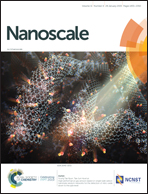Electrochemical impacts complement light scattering techniques for in situ nanoparticle sizing†
Abstract
We show that the electrochemical particle-impact technique (or ‘nano-impacts’) complements light scattering techniques for sizing both mono- and poly-disperse nanoparticles. It is found that established techniques – Dynamic Light Scattering (DLS) and Nanoparticle Tracking Analysis (NTA) – can accurately measure the diameters of ‘30 nm’ silver particles assuming spherical shapes, but are unable to accurately size a smaller ‘20 nm’ sample. In contrast, nano-impacts have a high accuracy (<5% error in effective diameters) and are able to size both individual ‘20 nm’ and ‘30 nm’ silver NPs in terms of the number of constituent atoms. Further study of a ‘20 nm and 30 nm’ bimodal sample shows that the electrochemical technique resolves the two very similar sizes well, demonstrating accurate sizing regardless of particle size polydispersity, whereas due to inherent limitations of light scattering measurements this is not possible for DLS and NTA. Electrochemical sizing is concluded to offer significant attractions over light scattering methods.



 Please wait while we load your content...
Please wait while we load your content...